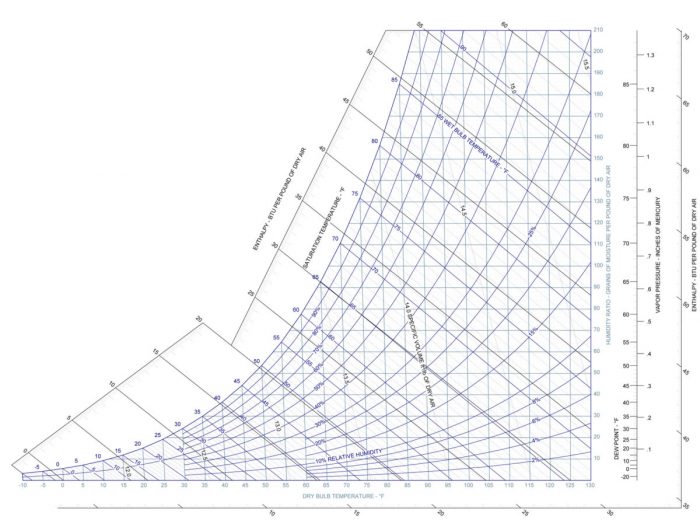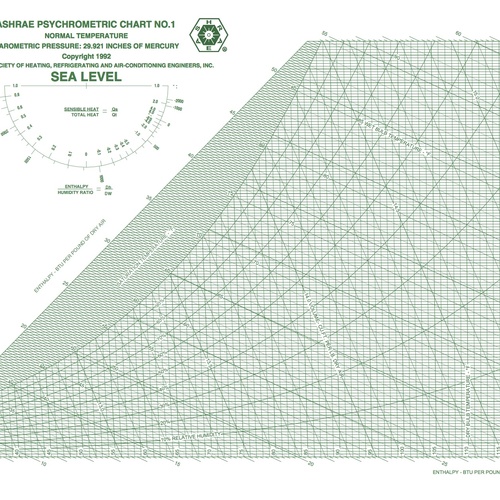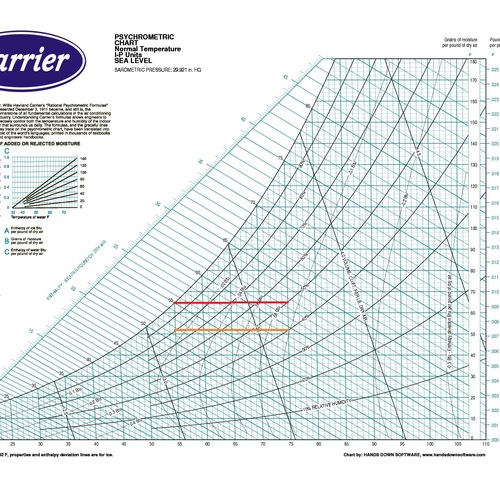
Image Credit: Mooganic
When you drive a borrowed car, it takes a few moments to figure out how to operate the windshield wipers and the headlights. But in your own car, your hand reaches for these switches without thinking.
Using the psychrometric chart is a little like driving a car. If you use the psychrometric chart every day, you don’t have to orient yourself. But if you are like me, and you only consult the psychrometric chart two or three times a year, it’s useful to refer to a cheat sheet every time you use it.
The psychometric chart (see Image #2, below) is a graph that shows (among other things) the relationships between air temperature, relative humidity, and dew points under a variety of conditions.

The psychrometric chart is your friend. Like the periodic table of the elements, it’s a very useful invention. It organizes a lot of information and presents it graphically, allowing builders, HVAC contractors, and building scientists to answer certain questions quickly.
Remember: if you need an answer to a question involving dew points or relative humidity, consulting the psychrometric chart is much easier than making calculations using a formula.
A crash course in psychrometrics
Here is my list of the top five things that builders need to know about air and water vapor.
1. Cold air can’t hold as much moisture as warm air. When the outdoor air is at 10°F, it isn’t holding much moisture — even if the relative humidity (RH) of the air is 90%. (In Comment #1 below, Bill Rose notes that “Saying that cold air can hold less water is convenient shorthand.” He goes on to note that in some instances — for example, when air in a stud bay is bounded by surfaces of different temperatures — the shorthand rule…
Weekly Newsletter
Get building science and energy efficiency advice, plus special offers, in your inbox.

This article is only available to GBA Prime Members
Sign up for a free trial and get instant access to this article as well as GBA’s complete library of premium articles and construction details.
Start Free TrialAlready a member? Log in















11 Comments
Air holding moisture
Saying that cold air can hold less water is convenient shorthand. I sometimes use that shorthand myself. However it masks the fact that that it is the temperature of the materials that bound (or the matter contained in) the air that governs the quantity of water contained in the air. Imagine a six-sided box with five warm sides and one cold side. The upper limit of dewpoint in the air will be the temperature of the cold side, while the "air temperature" in the box will be a function of the temperatures of all the sides. This important observation pertains directly to frame wall cavities.
Also, consider snowflakes. They are formed in supersaturated air (look up Ukichiro Nakaya), and the greater the amount of water above saturation (where air purity is a factor) the prettier the snowflake.
Response to Bill Rose
Bill,
It's always a pleasure to have you review my work.
You wrote, "Saying that cold air can hold less water is convenient shorthand." In most cases, I'm happy to employ convenient shorthand descriptions, especially when they are useful. However, I appreciate your point about stud cavities that are enclosed by surfaces at different temperatures. Your point is well taken.
Pilots, planes, and density
Pilots, planes, and density altitude oh my
http://flighttraining.aopa.org/magazine/2007/April/200704_Features_Takeoff_rules_of_thumb.html
Much worse than humidity.... Snow flakes just starting prior to departure.... No take off ... And the runway ends....thank fully in a grass transition area. Lots of interesting charts in a plane's operating handbook.
Walls; so cold exterior sheathing sets the in wall climate. Which sets up a differential from inside the home creating a driving force into the wall?
Bill Rose's box model is apt
Often people assume that condensation in a fiber-insulated stud bay will happen at some depth in the fiber. But since the fiber is air & vapor permeable, the dew point of that entrained air can't exceed the temperature of the cold side. All of the condensation (or adsorption) during condensation happens at the interior or exterior side surfaces, and not in the insulation.
Martin
Blogs like these that act as basic primers may not elicit the volume of responses more controversial ones do but they are immensely useful. Thanks.
Response to Malcolm Taylor
Malcolm,
Thanks for the feedback. I'm glad that you found the article useful.
Dew Point Calculator
Handy online calculator from Rochester Institute of Technology:
http://dpcalc.org/
Response to C.B.
C.B.,
Thanks for providing the link to a useful calculator.
Another psychrometric chart use
We use the psychro chart in an entirely different way. Using the chart variation that has passive strategies and a comfort zone mapped on it, as the initial phase of passive solar NZE design we chart monthly temps and humidities on the chart, and instantly get a graphic which tells us what passive strategies are appropriate to make a comfortable NZE building. It's a really neat trick against which to check one's intuitions without any computer work.
AC with windows open?
Hi I'm wondering what is the threshold where it would be wiser to leave my windows open at night with the AC, versus closing windows with AC. I typically set the AC to 77 degrees, and I find that when the outdoor temp is less than 65 degrees, the indoor temp the next morning is around 74 degrees. I'm assuming that early on the AC works and sucks that cooler air indoors, thus having to work less throughout the night. When the same conditions exist and I close windows, the indoor temp the next morning stays at 77 degrees. I assume the AC is working more through the night if I keep windows closed. My big question is at what outdoor temp/humidity would it be worse to go to sleep with AC set to 77 degrees with windows open? Thanks!
Response to Elliot Grochal
Elliot,
The answer to your question isn't simple. For more information, see this Q&A thread: Ramblings on thermal mass, AC and window fans.
Relevant comments from that thread:
James Morgan: "As a general point, just in case you're tempted, under no circumstances should you open windows at night and run a/c later in the day. Yes, it's that latent heat of vaporization thing. Whenever humidity is a factor in your cooling concerns air sealing is key."
Dana Dorsett: "I usually look at the outdoor dew point readings from a few nearby weather stations (they're often way off, especially the amateurs) before deciding if it's dry enough to make opening the windows worthwhile. If the outdoor dew points are 13C/55F or less it's fine to open the windows. But when the outdoor dew points are running 15C/59F and higher it becomes a real latent load if your goal is to keep it under 50% RH @ 23-25C.
"According to Wunderground weather station data the current dew points at this hour in Toronto are running in the 20C/68F range: https://www.wunderground.com/ca/on/toronto (Try checking a few stations using their "Change Station" pull down.)
"It will change over the course of the day, but if it's not under 60F, keep the windows closed even if it's cooler outside than indoors."
Charlie Sullivan: "Alan, your initial indoor conditions at 7 pm had a dew point of 23.4 C, while the outside dew point was 19 C. That means you could have used open windows and/or a whole-house fan to do the initial work, for the first few hours, and then had less work for the A/C to do. Dana's suggestion, to open windows when the outside dew point is lower than the inside dew point, works well to maximize your opportunity to reduce the load on the A/C through the use of outside air. Understanding why that works is harder than doing it, so it's understandable that it's not immediately obvious.
"To find inside dew point, you can either:
* Read a chart
* Enter the temperature and humidity readings into a psychrometric calcuator app on your smart phone (there are some free ones that work just fine).
* Enter the temperature and humidity readings into a psychrometric calcuator on the web
* Get a fancier indoor weather station that displays the dew point reading directly.
"As for how it works, the dew point also corresponds to the "humidity ratio" which is sometimes called "absolute humidity" to distinguish it from relative humidity. A 23.4 C dew point corresponds to 1.8 kg of water vapor per 100 kg of dry air, whereas a 19 C dew point corresponds to 1.4 kg of water vapor per 100 kg of dry air. So flushing out 23.4 C dew point air and replacing it with 19 C dew point air will mean you are removing some of the moisture from the air inside. Then when the A/C later cools the space it will not need to do as much dehumidification.
"One of the complications in understanding how fast you can cool and dehumidify a space is that there is moisture storage in the interior finish materials in your house, and in the furniture, books, etc., and on the surfaces of them. So at first your A/C is just dehumidifying the air. But then moisture starts to come out of and off of the the stuff in the house. It's the moisture equivalent of thermal mass--your A/C is also cooling all those materials and objects, not just cooling the air. But that's probably part of why it appears that your relative humidity inside gets down to 60% and sticks there even while you continue to remove substantial moisture each hour.
"Another factor is infiltration of outside air, even with the windows closed, which will tend to raise humidity in the house whenever the outside dew point is higher than the inside dew point."
Log in or become a member to post a comment.
Sign up Log in